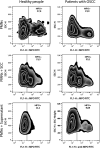Cancers Cells in Traps? The Pathways of NETs Formation in Response to OSCC in Humans-A Pilot Study
- PMID: 33073595
- PMCID: PMC7791464
- DOI: 10.1177/1073274820960473
Cancers Cells in Traps? The Pathways of NETs Formation in Response to OSCC in Humans-A Pilot Study
Abstract
The aim of the experiment was to evaluate the process of neutrophil extracellular traps (NETs) formation in patients with oral squamous cell carcinoma (OSCC) in response to direct or indirect contact with SCC cells in comparison to results obtained in the cells of healthy subjects. To fulfill study objectives CAL 27 cell line and blood were obtained from cancer patients and control subjects. Parameters related to NETs formation were analyzed utilizing flow cytometry, fluorescence microscopy, and ELISA-type tests. The expression of selected phosphorylated proteins of the PI3K/Akt/PBK pathway in neutrophils was evaluated using the Western blot method. An increase in NETs formation was observed in a coculture of neutrophils with SCC cells, with the largest amount of NETs formed after stimulation with a supernatant obtained from the SCC culture. The enhanced process of NETs formation was accompanied by changes in the expression of proteins from the PI3K/Akt/PBK pathway. The obtained results prove the existence of interactions between neutrophils and cancer cells resulting in NETosis with the participation of the PI3K/Akt/PBK pathway in patients with OSCC.
Keywords: NETs; PI3K/Akt/PBK; SCC; neutrophils; oral cancer.
Conflict of interest statement
Figures



Similar articles
-
Unobvious Neutrophil Extracellular Traps Signification in the Course of Oral Squamous Cell Carcinoma: Current Understanding and Future Perspectives.Cancer Control. 2023 Jan-Dec;30:10732748231159313. doi: 10.1177/10732748231159313. Cancer Control. 2023. PMID: 36814071 Free PMC article. Review.
-
Neutrophil extracellular traps (NETs) formation induced by TGF-β in oral lichen planus - Possible implications for the development of oral cancer.Immunobiology. 2020 Mar;225(2):151901. doi: 10.1016/j.imbio.2019.151901. Epub 2019 Dec 19. Immunobiology. 2020. PMID: 31882256
-
AKT3 is a key regulator of head and neck squamous cell carcinoma.Cancer Sci. 2021 Jun;112(6):2325-2334. doi: 10.1111/cas.14911. Epub 2021 May 1. Cancer Sci. 2021. PMID: 33811778 Free PMC article.
-
NETs biomarkers in saliva and serum OSCC patients: One hypothesis, two conclusions.Adv Med Sci. 2022 Mar;67(1):45-54. doi: 10.1016/j.advms.2021.12.004. Epub 2021 Dec 28. Adv Med Sci. 2022. PMID: 34971930
-
[Progress in mechanism of formation of neutrophil extracellular traps: Review].Xi Bao Yu Fen Zi Mian Yi Xue Za Zhi. 2020 Jun;36(6):561-564. Xi Bao Yu Fen Zi Mian Yi Xue Za Zhi. 2020. PMID: 32696748 Review. Chinese.
Cited by
-
The 'Danse Macabre'-Neutrophils the Interactive Partner Affecting Oral Cancer Outcomes.Front Immunol. 2022 Jun 16;13:894021. doi: 10.3389/fimmu.2022.894021. eCollection 2022. Front Immunol. 2022. PMID: 35784290 Free PMC article. Review.
-
Exploring beyond Common Cell Death Pathways in Oral Cancer: A Systematic Review.Biology (Basel). 2024 Feb 6;13(2):103. doi: 10.3390/biology13020103. Biology (Basel). 2024. PMID: 38392321 Free PMC article. Review.
-
The role of novel programmed cell death in head and neck squamous cell carcinoma: from mechanisms to potential therapies.Front Pharmacol. 2023 Sep 25;14:1228985. doi: 10.3389/fphar.2023.1228985. eCollection 2023. Front Pharmacol. 2023. PMID: 37818196 Free PMC article. Review.
-
Bidirectional roles of neutrophil extracellular traps in oral microbiota carcinogenesis: A systematic review.Transl Oncol. 2025 Jun;56:102361. doi: 10.1016/j.tranon.2025.102361. Epub 2025 Apr 15. Transl Oncol. 2025. PMID: 40239243 Free PMC article. Review.
-
Neutrophil extracellular traps: New players in cancer research.Front Immunol. 2022 Aug 19;13:937565. doi: 10.3389/fimmu.2022.937565. eCollection 2022. Front Immunol. 2022. PMID: 36059520 Free PMC article. Review.
References
-
- Brinkmann V, Reichard U, Goosmann C, et al. Neutrophil extracellular traps kill bacteria. Science. 2004;303(5663):1532–1535. - PubMed
MeSH terms
Substances
LinkOut - more resources
Full Text Sources
Medical
Research Materials
Miscellaneous

